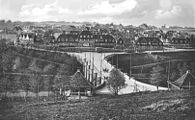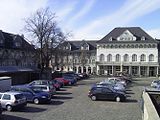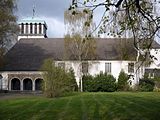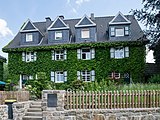Margarethenhöhe
|
Margarethenhöhe |
|

|
|
| Basic data | |
|---|---|
| surface | 1.48 km² |
| Residents | 7337 (March 31, 2020) |
| Coordinates | 51 ° 25 '57 " N , 6 ° 58' 38" E |
| height | 105 m |
| Incorporation | Jun 21, 1905 |
| Spatial assignment | |
| Post Code | 45149 |
| District number | 41 |
| district | District III Essen-West |
| image | |
|
View from the southeast of the Margarethenhöhe (2009) |
|
| Source: City of Essen statistics | |
The Margarethenhöhe is a southern district of the city of Essen . Its core is the Margarethenhöhe settlement , which is considered the first German garden city .
The 115 hectare estate managed by the Margarethe Krupp Foundation is an example of human-friendly living. It has 3092 residential units in 935 buildings. 50 hectares of the settlement area are defined as unbuildable woodland.
history
The area belongs to the Rüttenscheid district , which was incorporated into Essen in 1905. The Margarethenhöhe was donated in 1906 by Margarethe Krupp on the occasion of the wedding of her daughter Bertha and built from 1906 to 1938 by the architect Georg Metzendorf (1874–1934), a member of the Deutscher Werkbund . During the time of its construction, like the garden city of Dresden- Hellerau , it was exempt from all building regulations by a government decree.
The first houses on the heights were completed in 1910. The viaduct had previously been built over the Borbeck Mühlenbachtal in 1909 to develop and supply the new site with building materials and to connect it to the central settlement areas of Holsterhausen and Rüttenscheid. The viaduct also ran over the Mülheim-Heißen-Altendorf (Ruhr) railway line opened in 1872 with the Margarethenhöhe passenger station (1946 to 1965). The station building was later demolished and the railway line shut down and replaced by a cycle path in 1999.
In 1924 the Margarethenhöhe received a Catholic church , which was destroyed in the Second World War in 1944. Today's Catholic Church, the Holy Family , was consecrated in 1952; since 2008 it has been the parish church of the parish of St. Antonius.
After the Second World War, the settlement, which had been largely destroyed, was restored to its historical form. In 1948 the Margarethenhöhe became an independent district.
On the still undeveloped land south of the first settlement, the Margarethenhöhe II settlement was built from 1962 to 1966 and 1971 to 1980, partly architecturally inferior, and especially in the last construction phase, which also included high-rise buildings, socially problematic. According to the foundation, these houses set “a clear design contrast to the old Margarethenhöhe”. In order to remedy the social, technical and aesthetic problems of Margarethenhöhe II, a renovation program was started as early as 1987, which was intended to significantly increase public appreciation of the younger settlement unit of Margarethenhöhe […] .
Margarethenhöhe I, however, was placed under monument protection in 1987 . A model apartment set up by the Ruhr Museum visualizes the original design of the residential units and is intended to make “the cultural significance of the Margarethenhöhe monument with its variable floor plans visible from the interior perspective”.
At times there was also a small artist colony on Margarethenhöhe, whose most important guest was the photographer Albert Renger-Patzsch . This colony was dissolved in the 1930s, only the Margarethenhöhe ceramic workshop still exists. After 1933 it moved to the Zeche Zollverein , where the then Gelsenkirchener Bergwerksverein AG provided rooms on a colliery site.
The local researcher Hugo Rieth (1922-2006) was a chronicler of the garden city Margarethenhöhe. His publications in newspapers and yearbooks attest to his well-founded historical expertise, for which he received honors during his lifetime, including the Rhineland Taler and the Federal Cross of Merit. Hugo Rieth had an extensive library with documents, records and other historically significant evidence, as well as an extensive photo collection, which is now in the Essen city archive , the Margarethenhöhe citizenship and the Essen aviation archive .
coat of arms
Blazon : “In green a four-pinned golden (yellow) arched wall; above two bars of silver (white) daisy flowers with golden (yellow) butts and below in the base of the shield a daisy flower. "
The coat of arms was designed by Kurt Schweder and never had an official character. At the end of the 1980s, the heraldist created coats of arms for all of Essen's districts. They have meanwhile been well received by the Essen population. The coat of arms is a so-called " talking coat of arms "; the daisies allude to the name of the founder Margarethe Krupp . The battlements are reminiscent of the former Sommerburg weir system as well as the bridge over the Mühlenbachtal and the former Mülheim-Heißen-Altendorf railway on Sommerburgstrasse.
character
population
On March 31, 2020, 7,337 people lived in Margarethenhöhe.
Structural data of the population in Margarethenhöhe (as of March 31, 2020):
- Share of the population under 18 years of age: 15.4% (Essen average: 16.2%)
- Population of at least 65-year-olds: 26.5% (Essen average: 21.5%)
- Proportion of foreigners: 7.5% (Essen average: 16.9%)
Transport links
Historically, Margarethenhöhe is on the Mülheim-Heißen-Altendorf railway line , which is now a cycle path .
Today Margarethenhoehe southern terminus of the line U17 of the Stadtbahn Essen . There is a connection to the 169 bus line. Both connections are operated by the Ruhrbahn .
| line | Line course | Tact |
|---|---|---|
| U 17 |
U E-Altenessen , U Karlsplatz - U Altenessen Mitte - U Kaiser-Wilhelm-Park - U Altenessen Bf - |
10 min |
| 169 |
Essen-Margarethenhöhe 1 - Bredeney 2 - Werden Mon – Fri: section 2–3 every 10 min, sections 1–2 and 3–4 every 20 min; Sat / Sun: Sections 2–3 every 15 minutes, Sections 1–2 and 3–4 every 30 minutes |
20 min |
Every day during the day there is an hourly public bus from the Alfried Krupp Hospital to Haarzopf . The VRR tariff does not apply here.
Margarethenhöhe is connected to the federal trunk road network via the double junction 27/28 Essen-Haarzopf / Essen-Rüttenscheid of the federal highway 52 .
Varia
The architectural uniformity of the settlement goes back to a trick to save costs: Although not all houses should look identical, designing each building individually would have exceeded the financial framework. Therefore, Metzendorf designed a set of elements that were repeatedly combined in new ways. As a result, the houses all differ from one another, but remain stylistically closed.
Since it was founded and up to the present day, Margarethenhöhe has been run by the “Margarethe Krupp Foundation for Housing Welfare”. Although the living space to be managed by it was actually intended for the "lower-income classes", Margarethenhöhe I in particular has been transformed into a middle-class residential area to this day. In the city this is often attributed to a clique within the settlement, which nepotistically prefers its own family members. Today, in addition to numerous smaller shops for everyday needs, there are also a primary school, a ballet and music school, three kindergartens and an ice cream parlor on Margarethenhöhe.
The treasure tomb fountain on the market square summarizes in the above context as follows:
"Do not dig treasures with spades / seek them in noble deeds!"
In the files of the Leipzig City Archives there is a letter from Margarethe Krupp from 1905. In it, she asked to send her information material to the Meyer's Foundation in Leipzig , which happened as requested. A year later, she founded the Margarethe Krupp Foundation in Essen, which with 3,100 apartments and 60 commercial space is still Germany's largest housing foundation to this day.
literature
- Georg Metzendorf (ed.): Small apartment buildings and settlements . Alexander Koch publishing house, Darmstadt 1920.
- Johannes Leßmann: Ceramic workshop Margarethenhöhe GmbH. In: Home calendar for the city and district of Essen. 1940, ZDB -ID 980458-4 , pp. 164-169.
- Hans G. Kösters: The big hit. The Margarethenhöhe. Beleke, Essen 1991, ISBN 3-8215-0255-X . (belongs to Nobel illustrated book )
- Rainer Metzendorf: Georg Metzendorf 1874–1934. Settlements and buildings. Self-published by the Hessian Historical Commission, among others, Darmstadt 1994, ISBN 3-88443-185-4 . (= Sources and research on Hessian history 96), (at the same time: Aachen, Techn. Hochsch., Diss., 1993)
- Rainer Metzendorf, Achim Mikuscheit: Margarethenhöhe - experiment and model . Ed .: Margarethe Krupp Foundation for Housing Welfare. Pomp, Essen 1997, ISBN 3-89355-159-X .
- Hugo Rieth: The Margarethenhöhe in old views . Essen 1999, ISBN 90-288-6604-3 . (part of the Die Damals series )
- Andreas Helfrich: The Margarethenhöhe Essen. Architect and client against the background of local politics in Essen and company politics in Krupp between 1886 and 1914. VDG, Weimar 2000, ISBN 3-89739-105-8 . (Simultaneously: Darmstadt, Univ., Diss., 1999)
- Hugo Rieth: Essen-Margarethenhöhe . Sutton, Erfurt 2005, ISBN 3-89702-911-1 . (Part of The Archive Pictures Series )
- Manfred Kaczerowski: People of the Margarethenhöhe . Books & Friends, Essen 2006, ISBN 3-9810996-4-8 . (Catalog for the exhibition at Margarethenhöhe in 2006; [100 years])
- Wulf Mämel: Margarethenhöhe: the work of the century . Ed .: Margarethe Krupp Foundation for Housing Welfare. Beleke, Essen / Dortmund / Düsseldorf / Lübeck / Wiesbaden 2006, ISBN 3-8215-0556-7 .
- Heinrich Theodor Grütter (Ed.): The garden city Maragarethenhöhe. Architecture and history . Klartext Verlag, Essen 2014, ISBN 978-3-8375-1141-3 .
- Ludger J. Sutthoff: A guide to the maintenance and design of the Margarethenhöhe settlement in Essen. In: Yearbook of the Rheinische Denkmalpflege. Volume 46, Petersberg 2018, ISBN 978-3-7319-0645-2 , pp. 129-136.
Web links
- Description of this settlement as part of the Route of Industrial Heritage
- Entry on the Margarethenhöhe settlement in the “ KuLaDig ” database of the Rhineland Regional Council
- Extract from the list of monuments of the city of Essen
- Citizenship Essen-Margarethenhöhe eV
- Information about the Margarethenhöhe at Monumente Online
- Tours with Rainer Metzendorf through the settlement
- Virtual tour taken by Heiko Stachel
See also
- List of architectural monuments in Margarethenhöhe
- List of streets in Essen-Margarethenhöhe
- List of sights in Essen
- Margarethensiedlung in Duisburg-Rheinhausen
Individual evidence
- ^ AE Brinckmann, councilor council: Margarethen-Höhe near Essen . Ed .: Margarethe Krupp Foundation for Housing Welfare. Alexander Koch publishing house, Darmstadt 1913.
- ^ Rainer Metzendorf: Georg Metzendorf. 1874-1934. Settlements and buildings . Self-published by the Hessian Historical Commission Darmstadt and the Historical Commission for Hesse, Darmstadt 1994, ISBN 3-88443-185-4 , p. 80 ff .
- ^ Hugo Rieth: Essen-Margarethenhöhe . In: Series of archive images . Sutton Verlag, Erfurt 2005, ISBN 978-3-89702-911-8 , p. 40 .
- ^ Gerhard Steinhauer: Garden City Margarethenhöhe. 50 years of the Margarethe Krupp Foundation for housing welfare in Essen . Ed .: Margarethe Krupp Foundation for Housing Welfare. Self-published, Essen 1956, p. 81 ff .
- ^ City of Essen: History of the Margarethenhöhe ; accessed on April 25, 2019
- ↑ Living on the Margarethenhöhe. Retrieved April 18, 2019 (German).
- ↑ Rainer Metz village Achim Mikuscheit: architectural guide through the garden city Margarethenhöhe . In: Small writings of the Ruhr Museum . 1st edition. tape 4 . Klartext Verlag, Essen 2016, ISBN 978-3-8375-1142-0 , p. 83 ff .
- ↑ Rainer Metz village Achim Mikuscheit: architectural guide through the garden city Margarethenhöhe . In: Small writings of the Ruhr Museum . 1st edition. tape 4 . Klartext Verlag, Essen 2016, ISBN 978-3-8375-1142-0 , p. 60 ff .
- ^ Heinrich Theodor Grütter, Axel Heimsoth; Ruhr Museum: Departure in the West. The Margarethenhöhe artists' settlement . Klartext Verlag, Essen 2019, ISBN 978-3-8375-2100-9 .
- ↑ Rainer Metz village Achim Mikuscheit: Margarethenhoehe - experiment and model . Verlag Peter Pomp, Bottrop, Essen 1997, ISBN 3-89355-159-X , p. 55 ff .
- ^ Hugo Rieth: Essen-Margarethenhöhe . In: Series of archive images . Sutton Verlag, Erfurt 2005, ISBN 978-3-89702-911-8 .
- ↑ See on this Johann Rainer Busch: Kurt Schweders coat of arms of the Essen districts. Essen 2009, p. 63.
- ↑ Population figures of the districts
- ↑ Proportion of the population under 18 years of age
- ↑ Proportion of the population aged 65 and over
- ↑ Proportion of foreigners in the city districts
- ↑ Timetable and tariff , Citizen Bus Essen HMR
- ↑ https://www.lvz.de/Leipzig/Lokales/Stiftung-Meyer-sche-Haeuser-in-Leipzig-wird-120-Jahre-alt , accessed on June 14, 2020











